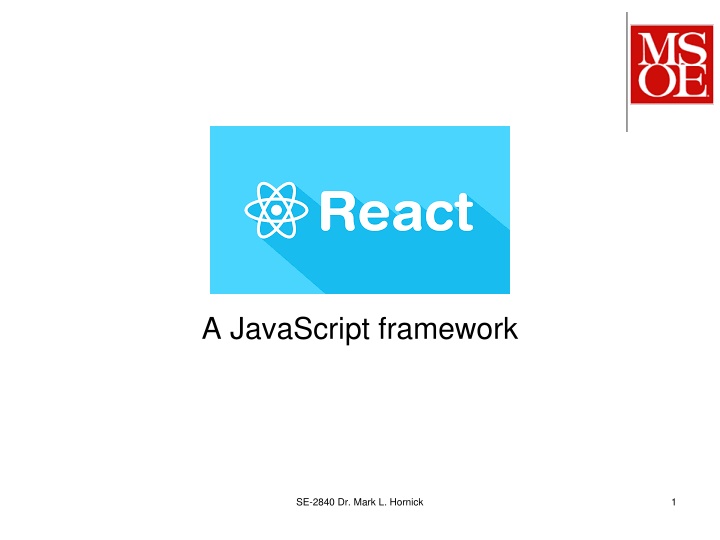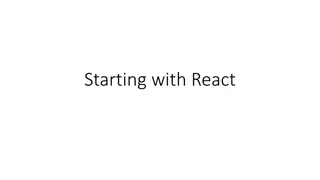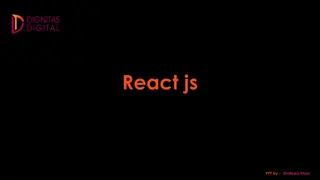
JavaScript Frameworks and React - Dr. Mark L. Hornick's Insight
Explore key concepts like MVC, jQuery, Virtual DOM, and React through the expertise of Dr. Mark L. Hornick in this comprehensive guide. Learn how React simplifies web app development by syncing HTML components with JavaScript, enhancing efficiency and user experience.
Download Presentation

Please find below an Image/Link to download the presentation.
The content on the website is provided AS IS for your information and personal use only. It may not be sold, licensed, or shared on other websites without obtaining consent from the author. If you encounter any issues during the download, it is possible that the publisher has removed the file from their server.
You are allowed to download the files provided on this website for personal or commercial use, subject to the condition that they are used lawfully. All files are the property of their respective owners.
The content on the website is provided AS IS for your information and personal use only. It may not be sold, licensed, or shared on other websites without obtaining consent from the author.
E N D
Presentation Transcript
A JavaScript framework SE-2840 Dr. Mark L. Hornick 1
Introductory topics MVC jQuery/DOM manipulation Virtual DOM Components Babel JSX Webpack SE-2840 Dr. Mark L. Hornick 2
React Executive Summary Created/Backed by Facebook First prototype with php in 2010 Open-sourced in 2013 Stable 2015 Adaptation 2016 - present 2019 stable release is 16 React allows you to write special HTML components that synchronizes with your JavaScript leaving you to write your application logic instead of manually updating the DOM. SE-2840 Dr. Mark L. Hornick 3
Review What is the Model-View-Controller pattern about? SE-2840 Dr. Mark L. Hornick 4
What is React and what problem(s) does it address? First, consider the structure of the web apps you have done so far: Does the code present a clean implementation of the MVC pattern? Where is the View implemented? what code file(s)/module(s) create or modifie what is seen in the browser? Where is the Controller implemented? what code is responsible for getting data and deciding what data is to be displayed? Where is the Model implemented? what code is responsible for storing data? 5
HTML/jQuery approach mixes Controller and View The typical paradigm is as follows: Access a DOM element Read its value Send the value to the Model OR Read a value from the Model Access a DOM element Update its content with the value SE-2840 Dr. Mark L. Hornick 6
Typical jQuery approach $('#program').html(track.curriculum); $('#year').html(track.year); $('#quarter').html(track.term); $('#courselist').empty(); // clear the course list (note: managing the ui here) $('#courselist').append("<ul class='list-group'>"); // add the <ul> element track.courses.forEach((course, index) => { // iterate all courses // note html mixed with script (ui+control = low cohesion/bad code smell) $('#courselist > ul').append("<li class='list-group-item list- group-item-success'>" + course.id + " : " + course.desc + '</li>'); }); // end forEach Green = UI markup Blue=UI manipulation in control code ALSO: Manipulating the DOM is slow and CPU intensive SE-2840 Dr. Mark L. Hornick 7
Low cohesion! High coupling! Bad code smell! Note that the JavaScript knows about the View, since it explicitly has to add a <li> element to the <ul> This is an example of poor cohesion and tight coupling SE-2840 Dr. Mark L. Hornick 8
React Motivation Evolution has moved wep app architecture towards SPA (single page applications) , where the : Server implements the Model (e.g. Phonebook) Client (browser) implements the View and Controller The Controller is responsible for Getting data from the server and making it accessible to the view. Extracting data from the view and posting it to the server The View is responsible for Deciding how to display components/elements and information to ensure a unified UI experience (desktop, tablets, phones) SE-2840 Dr. Mark L. Hornick 9
React is one of many competing frameworks that attempt/promise to: Decouple DOM manipulation from app logic (control) Decouple client-side from server-side Improve testability Make common coding tasks easier This is changing rapidly. To get the latest, google javascript mvc frameworks SE-2840 Dr. Mark L. Hornick 10
2017 survey results: Google: angularjs vs other frameworks for many differing opinions SE-2840 Dr. Mark L. Hornick 14
React (generally, web frameworks) are notperfect Not a good fit for applications that require intensive and tricky DOM manipulation of the DOM (ie games, gui editors) In such cases, it may be better to use a library that exposes a lower level of abstraction, like jQuery Although React Canvas might be just as good React has been accused of being a memory hog SE-2840 Dr. Mark L. Hornick 16
Using Reacts createElement() method to create a Virtual DOM element: <p id= p1 class= text-primary >Hello SE2840</p> createElement( p , { id : p1 , className : text-primary }, Hello SE2840 ) Syntax: createElement( type, [props], [ children] ) Type tag name string ( div , p , etc) Props element properties as a Javascript object Since class is a js reserved word, we must use className children an iterable (0 or more) Creates/returns a ReactElement object SE-2840 Dr. Mark L. Hornick 17
Using Reacts createElement() method to create: <h1> </h1> <p class= text-primary >Hello</p> createElement( h1 ,null, createElement( p , { id : p1 , className : text-primary }, Hello ) ) Note that the nested createElement() is the 3rd argument to the first createElement() The nesting of calls can be repeated as much as necessary. SE-2840 Dr. Mark L. Hornick 18
Basic React approach: (nobody actually does this for illustration purposes only!) Include a couple of <scripts> into your html: <!-- These are the React core modules --> <script src="https://unpkg.com/react@15.4.2/dist/react.js"></script> <script src="https://unpkg.com/react-dom@15.4.2/dist/react-dom.js"></script> In the js file, use React s createElement() method to build an VirtualDOM locally: let listitems = []; track.courses.forEach( (course, index) => { let element = React.createElement("li", {key:index, 'className':'list-group-item list-group-item-info'}, (course.id + ' : ' + course.desc) ); listitems.push(element); } ); // end forEach let unsignedlist = React.createElement("ul", {'className': 'list-group'}, listitems ); // This tells React where to render the virtual DOM structure ReactDOM.render(unsignedlist, document.getElementById("courselist")); HTML-like elements still in code; We need to separate this out! Use ReactDOM.render to display the VirtualDOM (much more efficient). SE-2840 Dr. Mark L. Hornick 19
A much better React approach - (separate the control code from the view code) Include a couple of <scripts> into your html: <!-- These are the React core modules --> <script src="https://unpkg.com/react@15.4.2/dist/react.js"></script> <script src="https://unpkg.com/react-dom@15.4.2/dist/react-dom.js"></script> Use ReactDOM.render to display the VirtualDOM (much more efficient). $('#program').html(track.curriculum); $('#year').html(track.year); $('#quarter').html(track.term); // This tells React where to render the virtual DOM structure ReactDOM.render(<Courselist items={track.courses}/>, document.getElementById("courselist")); But have the control code use Courselist, a custom view component that is defined elsewhere, and provide that component with data SE-2840 Dr. Mark L. Hornick 20
A much better React approach (the view code) Include a couple of <scripts> into your html: <!-- These are the React core modules --> <script src="https://unpkg.com/react@15.4.2/dist/react.js"></script> <script src="https://unpkg.com/react-dom@15.4.2/dist/react-dom.js"></script> Use JSX to define the view almost identical to regular HTML (except className ) class Courselist extends React.Component { render() { return <ul className='list-group'> { // Javascript in the middle of JSX needs to be delimited with {} this.props.items.map((course, index) => <li key={index} className='list-group-item list-group-item- danger'> {course.id + ' : ' + course.desc} </li> ) } </ul> } // end render() } controller JSX can embed Javascript to get at data (that is, the items array) provided by SE-2840 Dr. Mark L. Hornick 21
But JSX is not Javascript, so we have to use the Babel transpiler to convert it to regular Javascript The view code as transpiled by Babel: class Courselist extends React.Component { render() { return React.createElement("ul", { className: "list-group" }, // Javascript in the middle of JSX needs to be delimited with {} this.props.items.map((course, index) => React.createElement("li", { key: index, className: "list-group-item list-group-item-danger" }, course.id + ' : ' + course.desc))); } // end render() In our html file, we need to include the Babel-script rather than the original script containing the JSX SE-2840 Dr. Mark L. Hornick 22
Lab 8 Tables must use the same React Component You ll be developing a React Component to represent both tables The buses on route table contained (rt, vid, spd, lat, lon, dist) The speeding bus table contained columns (rt, vid, spd, lat, lon, tmstmp) Write your Component to conform to the speeding bus format Both tables will display the same data format The same information is in both Ajax responses from your Node server (although the buses on route response has more information) MAKE SURE ONLY THE TABLE SCROLLS SE-2840 Dr. Mark L. Hornick 23






















